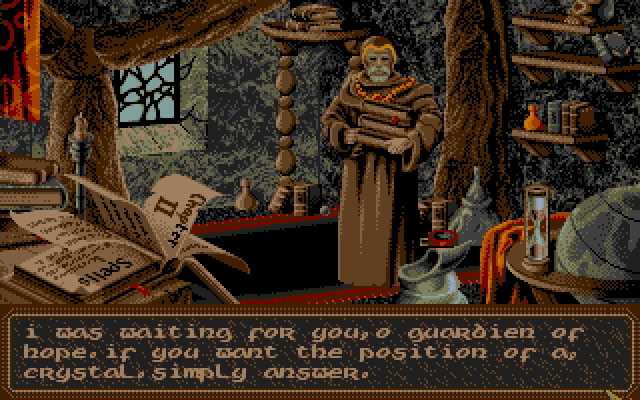If a picture paints a thousand words, then a 3D engine wipes-away 900.
Even a 3D engine with “a great game” and “good level-designers” still only manages five hundred.
It’s taken me a long time to realise this, but … games published today often have inferior visual Art to games published 20 years ago.
Working inside game studios you still get to see stunning art on a daily basis – it’s just that none of that ever makes it into the game. It’s all “concepting”: static, one-off paintings. And although it’s only a minor issue, I feel we’ve lost something in having these moments fade away from the games themselves.
I don’t have time to carefully research and pick my examples, so I’ll just pull straight from memory (and hope the point still makes sense by the end :))
1991-1994: in-game graphics
This is going to be hard to demonstrate if you judge each image too literally, but bear with me…
I’ll start with one of the most “art” games of the 1990s: Another World (1991):

Another World is easy for this post: the whole game was designed around “how good can the visual art be … with a very small colour palette, no shading, and very blocky characters?”
Here’s a screenshot from Ishar 2 (I think; could be Ishar 3?) – either way, 1993-1994:
Ugly, horrible. Composition is mediocre.
And yet … just have a look at the open book on the left-hand side, opened, with the pages caught in the act of riffling in a breeze. Hand-painted in *very* low resolution, with readable text.
Look around the room, look at how much stuff is crammed in a single image. Why? Because none of it had to be modelled in 3D – the game was crammed full of this kind of whimsical artistic painting, full of imagination.
Or look at Elf – published 19 years ago! Here’s two screenshots. First, look at the “normal” graphics in this platform game:
http://www.mobygames.com/game/dos/elf/screenshots/gameShotId,315213/
…now look at one of the “boss” screens:
http://www.mobygames.com/game/dos/elf/screenshots/gameShotId,315213/
In the second screenshot look at the background: hand-painted, but also soft-focus, to provide greater contrast with the player and the boss. I want you to consider the technique, rather than the actual screenshot – this is a poor example, sadly – but my copy of Elf is FUBAR so I can’t take a good one.
2010: the missing Art
15 years later, how has the artwork improved?
The engines produce stunning visual effects, fully animated, in 3D. Sony and Nintendo are now putting their games onto mass-market 3D displays so you see *actual* 3D images, rather than 2D simulation of a 3D scene.
But the artwork has atrophied. Modern games have no time to spare for epic vistas – there’s no room in the gameplay for static screens.
And it’s phenomenally expensive too: it used to be that painting a 100×100 pixel area of screen required 10,000 pixels to be painted – a matter of minutes with a good photo app.
Nowadays, you have to create 3D models – separately – for each item that will appear in that area. Then you have to paint textures for each one – usually 100 times as many pixels *each* as in the 2D equivalent – and apply lighting by hand, and positioning in 3 dimensions.
Net effect: low-importance areas of scenes are empty and ill considered (artistically). Flights of fancy are rarely possible (developers literally can’t afford them – it costs too much money in the salaries of extra staff)
“You don’t take a photograph, you make it”
Don’t believe me? Then try this site, find a game you’ve played, and compare the images here to the images you *actually saw* in the game:
From the about page:
an emerging art form that’s as far from the average screenshot as it is the average photograph.
So … what?
Go back to the Ishar screenshot.
Fire up Oblivion (a modern equivalent: a sword-and-sorcery RPG), and look for anywhere in the game with even half as many “interesting” items that might spark the imagination. What are those things? What do they tell about the character of the person who lives here?
(in Oblivion, you’ll find that everyone has a fetish for broken crates and buys their chairs and tables from the same – apprentice – carpenter. Some of them have a couple of houseplants. That’s it.)
This post was about the visual art, but the loss is felt in the games themselves, in a loss of immersion, and a loss of *player* imagination. Sole-author flash games – often made by artists working alone – go some way to redressing the balance. Even if they didn’t, it’s small, and it’s subtle – it’s really not that important. But it’s a loss nevertheless.





